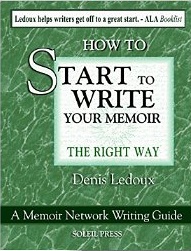 What could be an easier process to write a new book than to go to my Memoir Writers’ Blog, pullout some articles on the same topic, and put them together? After all, I had read How To Blog Your Book by Nina Amir, a helpful book that inspired and guided me in the composition of my latest book in the Memoir Network Writing Series, How To Start To Write Your Memoir.
What could be an easier process to write a new book than to go to my Memoir Writers’ Blog, pullout some articles on the same topic, and put them together? After all, I had read How To Blog Your Book by Nina Amir, a helpful book that inspired and guided me in the composition of my latest book in the Memoir Network Writing Series, How To Start To Write Your Memoir.
Getting Off to a Good Start
The Memoir Writer’s Blog had many informative posts about how to start the process of writing a memoir. I found, too, that I had many significant articles not only on the process of starting to write but also about self-doubt as a monstrous inhibitor of the writing process, about scheduling as a beneficial launcher, about creating personal and group support for taking the writing life seriously. As I perused these additional posts, I understood many were appropriate for How To Start To Write Your Memoir so I also pasted these into the document for my new book.
Soon, I was on my way to a short book-length manuscript. Not shabby as a start.
That initial lineup was just about the same as that of the order of the final draft of the book. My sense of developmental sequencing, of logical progression, felt strong and sure. Of course, there were still components missing from the articles I had selected and new text would have to be added into the manuscript. What needed to be added was simply not in the Memoir Writer’s Blog, and as I became aware of the gaps, I wrote new text into the book—and subsequently posted these in the blog.
So far no problem. I was a good student of How To Blog Your Book. The challenge, of course, was that any book—and my new book was no exception—requires the attentive and thoughtful application of a unifying sensibility.
Challenges Find Resolutions
At first, my solution was to create transition paragraphs between blog posts. These transitions might be as simple as “As mentioned earlier.” Other times, the transition was a bit more involved. It might go like this: “It is not always possible to do what I suggested in the previous section, and so in this section, I would like to add….”
 This worked quite well, and at one point, I had collated some 70 pages of text. As I read and reread the text, I continued to tweak the sections. I also added new material, some of which, again, was original. The transformation was clearly for the better.
This worked quite well, and at one point, I had collated some 70 pages of text. As I read and reread the text, I continued to tweak the sections. I also added new material, some of which, again, was original. The transformation was clearly for the better.
I Linger With My Manuscript
Soon, it was time to put the manuscript aside—I’m a great believer in lingering with your writing—and in this instance, my instinct was to do just that. After a few weeks of letting the text “lie fallow,” I returned to the manuscript. Unlike when I had put it down with the feeling that I was probably close to a finished book, after several weeks away, in spite of all the transition words and phrases, the book seemed disjointed. I did another edit-through with my usual scrutiny for conciseness, completeness, coherence, and clarity. (I call these the 4 Cs.)
“Perhaps this does it,” I thought after the careful edit. “I might just have finished the book!”
Again, I put the manuscript aside.
By being out of mind for a while, a book ceases to be my book and becomes a book that’s “out there.” In the re-read, I am the reader; I become someone who has a different “take” from the me who wrote the manuscript. I find this process essential to arriving at any objectivity about my prose—and it will be true for you, too.
I Realize What Was Wrong
When I returned to the text, I realized it still didn’t “work.” Fortunately, this time, I grasped what was wrong: the voice, the sensibility, the tone was too varied; there was no tonal unity to the book. It was full of well-written pieces that, in spite of all the transitional material, still felt too much as stand-alone posts. Without a revision of its voice, its tone, it would not come together as a book that was larger than the sum of its parts.
In short, while I could see that the book contained some really good ideas, I could also see that it didn’t “hang together”: it was saying many important things, but in too many disjointed ways.
What I did then was to ask myself, “From which facet of my self am I writing this book? What is the tone and the voice I want to give it?”
What ensued was a re-write that made the final book larger than the sum of the parts.
How to Start to Write Your Memoir became so much more than a collection of posts.
It became the book I was longing for.
About the Author
 Denis Ledoux is the author, most recently, of How to Start to Write Your Memoir which is Book One in the seven-part Memoir Network Writing Series. Also in publication is Don’t Let Writer’s Block Stop You. A complete list of publications is available here. To be placed on an alert list, send Denis an email.
Denis Ledoux is the author, most recently, of How to Start to Write Your Memoir which is Book One in the seven-part Memoir Network Writing Series. Also in publication is Don’t Let Writer’s Block Stop You. A complete list of publications is available here. To be placed on an alert list, send Denis an email.
Amazon links contain my affiliate code.

Leave a Reply